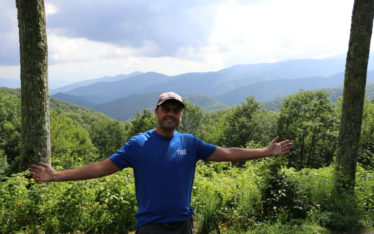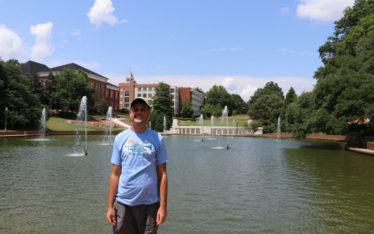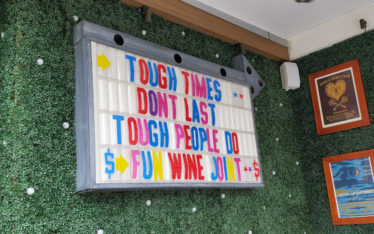Leaving Santa Fe we were on our way to our last stop in New Mexico in the town of Taos. As before when we drove around Santa Fe, the drive to Taos was awesome. People generally don’t think of New Mexico being in the Rocky Mountains but it is. Taos itself sits at almost 7000 feet elevation. Here we drove past high mountain vistas, broad valleys but still with high desert scenery of low shrubs, the occasional small cactus and yucca plant. Soon enough we reached Taos located just about an hour south of the Colorado border in North Central, NM. We checked into our campground and settled in for the night. (Side note – this campground has been one of our favorites of the trip, the Taos Valley RV Park. Great sites, desert landscaping, clean & quiet. It was great!)
Taos Pueblo
We woke up the next morning ready to explore. Taos is famous for a few things, its artists, world class skiing and the Taos Pueblo. The Taos Pueblo is a structure on a reservation for the Taos (Tiwa) Native American tribe. We had seen signs for it and read that it was the number one thing to see while in the town of Taos. So of course we wanted to go see it.
Growing up in Western New York Julie and I while accustomed to driving through Native American Reservations (The Mohawk, Seneca & Cayuga tribes to name a few) had never been able to stop at one before. The Tiwa people here in Taos were most famous for their pueblo. A pueblo is an adobe style structure that is generally multi-storied. The one here in Taos was the most famous one of them all.
Driving onto the reservation you are directed to a parking area then have to go and pay a fee of $16 per person. This fee allows you onto the grounds as well as to take a tour if you choose. Walking up to the pueblo felt like almost a religious experience. The oldest part of the pueblo has been dated to have been built somewhere between 1000 and 1450AD. People have lived in it ever since making it one of the oldest (if not the oldest) continuously lived in structures in the entire country. The pueblo is not a small one-story hut either. There are two buildings, each with some of the tallest parts being five stories tall. This is amazingly impressive considering the buildings are made with nothing more than dirt & clay mixed with water and straw supported with wood beams and roof/floor structure.
We opted to take a tour, which was led by a younger tribal college student. He said that all the tour guides were in college and used the tips to help pay to further their education. Walking around and seeing the building and hearing how it was built and how it was lived in was just fascinating. For starters the pueblo was built as it was as a defense mechanism against other tribes. It was built in almost a block triangle pattern where one room was built on top of another but not directly going up. Access was needed through each roof so each floor was slightly put back.
There are (or used to be anyway) no doors on the structure at all. Access into the structure was through the roof. Ladders were placed starting at ground level then going up with an opening in the roof and a ladder going down into the home. If the tribe were about to be attacked the ladder would simply be pulled up cutting off access.
In the structure itself a home usually consisted of two rooms. One room is for sleeping and the other for general living, cooking and storage. We were told that you are unable to purchase a home or additional homes. Once the structure was built it belonged to a family and it would stay theirs for more or less eternity. The individual family is also responsible for the upkeep of their individual home. Because of this we saw some areas of the pueblo that looked brand new and some that looked like they were falling apart.
We learned that generally now a family does not live in the pueblo full time (there is no running water or electricity) but they normally come for special occasions or just to spend a night every now and then. Most of the families who owned 1st floor “homes” turned them into business’s catering to the tourists. Some sold jewelry, while others musical instruments, art or baked goods. There were small adobe ovens located around the property, which were communal and used to make Native American style breads and sweets. Julie bought a pair of earrings and some fry bread with sugar and cinnamon. She said it was pretty tasty!
Taos & Tiwa History
Besides the building we also learned about some of the area history. While the Tiwa people had been in the area for thousands of years the first newcomers to the area were the Spanish arriving in 1615. Initially relations were good but after the Spanish tried to convert the tribe to Catholicism and force them to pay a tax the tribe revolted. The Tiwa people joined together with other pueblo tribes in the area and fought and forced the Spanish out. This was known as the Pueblo Revolt. The Spanish did not return to the area until 1692 when they took control for good. The region stayed in Spanish hands until the Treaty of Guadalupe Hidalgo in 1848 after the Mexican-American war and became a territory of the USA.
It really is interesting what surprises you. After 2+ years of traveling the North American continent when you think you’ve just about seen it all something like the Taos Pueblo comes along. This building, the Tiwa people, and their history has been here for so long and Julie and I just learned of it now. It really helped to fuel our passion to keep going, keep traveling and see what else is out there.
Taos
From the Pueblo we drove back into town and headed to the central square. Much like Santa Fe or the old town of Albuquerque the center of Taos (and the center of life in the town) is still around their old Spanish central square. We walked around and stopped into a few of the shops picking up a few touristy items and some New Mexican Piñon coffee (it’s seriously amazing). We were a bit hungry so we stopped by the Alley Cantina where we both had platters of their chile rellano platters. It was a great atmosphere and the food was amazing!
Brews & New Friends
After walking around town a bit more taking some video and pictures we headed to the outskirts of town to the Taos Mesa Brewery. I’m sure I’ve said this before but we always get the best local info or meet like-minded travelers at small local breweries. While we didn’t get local info here we did run into another van camper traveler David Lutz. We had seen his camper van around town a few times and when we saw him at the brewery we had to say hi. He had been traveling solo from California and was headed to New Orleans for his birthday then up to Alaska like we were. It was neat to talk travel with him and hopefully we meet up again on the road somewhere in Alaska or on the way in Canada.
After we finished our beers and conversation with David we headed out stopping to give Bubbles a wash at a local car wash and a stop at a Baskin-Robbins for a little ice cream before dinner. Who says you cant have a little dessert 1st! We then headed back to the campground for the night.
The next morning we packed up and headed out. Just a few miles outside of town we stopped after going over the Rio Grande Bridge. The bridge goes over the Rio Grande canyon. While not as impressive as the Grand Canyon the Rio Grand Canyon is pretty damn impressive. We stopped the van and took a walk around down a trail alongside the canyon then onto the bridge itself taking a few pictures. Once we were canyoned out we hopped back into Bubbles and headed north into Colorado.
Thank You New Mexico
New Mexico will always be a special place for Julie and I. Julie and I had no intention to come this far west when we set out from Tampa in April bound for Alaska. When you travel like we do though Mother Nature sometimes plays a big part in what you can see and where you can go. As luck would have it, we were forced from our planned route. We had so many great experiences in the state. We saw new cities, ate great food and made some amazing new friends. Thanks New Mexico, we will be back!
Next up…we head north! Colorado and Wyoming, here we come!


































